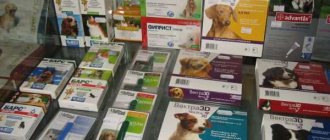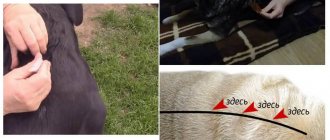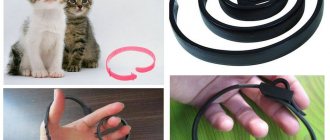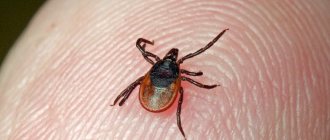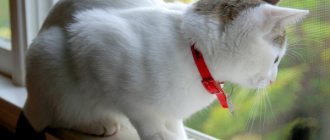The unfortunate fact is that pets can have fleas. Especially if this concerns small puppies, since removing fleas from a puppy 1 month old or even younger is problematic. There are very few drugs against blood-sucking insects that would be suitable for such babies. Fleas not only cause discomfort to puppies, but can also become carriers of serious infections. Flea bites cause allergies and dermatoses, which is why it is so important to get rid of parasites in a timely manner.
How dangerous are fleas for a puppy?
Flea bites cause pain to the puppy, and if severely infested, they can lead to apathy, refusal to eat, and a nervous breakdown. Fleas on a puppy can cause serious health problems:
- the immune system has not yet been formed, so infections carried by fleas are much more dangerous for small pets;
- flea saliva contains a large amount of biologically active substances that cause allergic reactions;
- if the dog is heavily infested and the size of the dog is small, flea feeding can lead to significant blood loss and cause anemia;
- fleas can become carriers of helminths, which deplete the animal’s body.
Puppies
Therefore, you should pay close attention to the fact that your pet is itching and take action in time. Flea remedies for your puppy should be chosen taking into account the conditions in which he lives and other factors.
How to protect puppies in the litter from fleas
Puppies are weaned from the bitch at the age of 1.5-2 months. But it happens that the baby goes to a new family at the age of one month. Babies become infected with insects from their mother, and choosing flea medications for puppies that are in the litter is more difficult. Even a small amount of insecticides applied to a dog’s fur can lead to poisoning of the bitch. If all puppies are licked, the dose of the drug entering the digestive system may exceed the permissible safe limit. Therefore, you should choose flea treatments for puppies that do not contain insecticides, but repellents based on natural ingredients, to reduce the risk of poisoning the canine family.
To remove fleas from a nursing dog and puppies that are kept in an enclosure or in a room separate from human habitation, you can place bunches of repellent herbs around the bed - leaves of wormwood, lavender, tansy, flea beetle, bedbugs, sweet clover, or sprinkle powder from these plants. They are safe for dogs, even if kids decide to try them, and the smell of herbs repels blood-sucking insects.
If puppies and their mother live in the house, then the bedding and the area next to it can be treated with water with the addition of a few drops of essential oil of lavender, lemon, cloves, menthol, eucalyptus. In addition to the repellent effect, this solution has a deodorizing and antimicrobial effect. You can also spray a puppy or dog against fleas with this solution, dry the fur and comb it.
Plants for fleas
If puppies and their mother live in the house, then the bedding and the area next to it can be treated with water with the addition of a few drops of essential oil of lavender, lemon, cloves, menthol, eucalyptus. In addition to the repellent effect, this solution has a deodorizing and antimicrobial effect. You can also spray a puppy or dog against fleas with this solution, dry the fur and comb it.
On a note!
To protect your dog from insects while walking, you can use an anti-flea collar with essential oils without adding insecticides or make such protection yourself - apply a few drops of essential oil to a neckerchief and tie it around the dog’s neck before a walk. For dogs older than 4 months, the Celandine collar is suitable.
You can use special tablets that are added to the bitch’s food. Once in the blood, they poison blood-sucking insects, but you should carefully read the instructions so that the drug does not get into the milk.
You should carefully monitor the litter in order to detect “bloodsuckers” in time and prevent them from multiplying too much. Water treatments for dogs with special shampoo help to completely destroy a small number of insects.
The smaller the baby, the more difficult it is to choose a flea remedy.
So how to treat small puppies for fleas?
For puppies, anti-flea medications at this age can be used for both therapeutic and preventive purposes. After all, prevention of any disease is always better than its treatment. The choice of drugs is now much wider. There are many different products on the shelves of pet stores and veterinary pharmacies: collars, drops, sprays, tablets. Most of them are approved for use by puppies from 2 months of age. The age at which the drug can be used should always be indicated in the instructions for the drug. Please read it carefully before use. Below in this article we will figure out how to choose a flea treatment that is suitable for your puppy, especially if fleas have already appeared.
Treatment of puppies up to 1 month
Even renowned companies do not produce anti-bloodsucker medications for babies under 1 month old. Therefore, only mechanical methods can be used to combat insects:
- Wash the dog in a strong decoction of repellent herbs. Pour warm broth into a basin and immerse the puppy in it for 10-15 minutes. It is necessary to ensure that the liquid does not get into the baby’s eyes, ears and nose. Then dry the wool and comb it thoroughly over a white cloth. If the kids are all together, then you need to treat all the dogs one by one.
- Bath the crumbs in tar soap. Lather the dog and wrap it in a towel for 5-10 minutes. Then thoroughly rinse off the foam, dry and comb out the fur.
Tar soap for fleas - Use special shampoo for babies for the bath. Doctor Zoo shampoo can be used for pets older than 2 weeks. When choosing a shampoo, you should read the instructions, which should indicate at what age the baby can safely use the product.
- Frontline spray is recommended for use for babies from the first days of life. It can be used on pregnant and lactating dogs.
Important!
In order to effectively exterminate insects, you should act comprehensively. Before deciding how to remove fleas from a puppy at home, you need to thoroughly treat the dog's bedding, bed and the entire room. Flea treatments for puppies are chosen especially carefully.
Flea treatment
Treating a puppy against fleas is a priority for any loving owner, since young animals are more sensitive to exhaustion and anemia. Since fleas multiply instantly, control must be carried out immediately after identifying the insects. In order to find out how to get rid of fleas, you need to evaluate each available product according to the characteristics and reviews of the owners.
There are so many dog breeders, so many opinions. Today, trading platforms offer a wide selection of insect repellents for animals, but each specific case must be considered individually. Of course, flea removal procedures can be carried out in veterinary clinics, however, the procedure does not require special skills, equipment or preparation of the pet; it can be done independently at home.
It is important to know that there is no means to remove insects forever. This is due to frequent infection, which always haunts the pet, because he goes for a walk several times a day, which means he will have to use insect repellent regularly.
Flea drops
Flea drops for puppies are an easy to use method. Drops can be used for adult dogs, although there are separate drops that can be applied to puppies from 2-3 months.
Dan drops can be used by puppies from 10 weeks of age. This flea remedy for puppies is also used in the fight against lice eaters, sarcoptic and ixodid ticks, lice, and parasites. Excipients penetrate into the localization of parasites, reducing the inflammatory process of the skin. The protective effect after treatment is observed for 1 month, in some cases it lasts for two months, and against ticks for at least two weeks.
The drug is applied to the withers and between the shoulder blades, so that the animal cannot lick the product. The death of insects on animals occurs within 24 hours. If ear scabies occur, then you need to drip 2-4 drops of the drug into the ear, fold the ear in half and massage it with your fingers, and repeat the course of therapy after a week. During treatment, protect your pet from swimming.
The disadvantages of drip treatment include the high cost of the drugs, and in some cases increased toxicity for dogs and people. Most flea drops can be used on puppies from six months of age.
The most commonly used drops for dogs and puppies:
- Frontline - the active ingredient Fipronil, an effective insecticide against insects. It is necessary to strictly follow the instructions for the safety of the procedure; licking may cause the animal to vomit.
- Stronghold is the active ingredient Selamectin. The drug is non-toxic, even if swallowed, and can be used for lactating bitches and pregnant dogs. Used to treat dogs of different breeds. Compatible with any veterinary products. Apply to the withers, pet can be petted after 30 minutes. Manufacturer USA.
- Bars is a cheap domestic product, sold in special pipettes. One pipette per procedure. It should be applied in several places along the vertebra. Reviews from dog owners talk about quick relief from fleas, the cost is 30 to 40 rubles per pipette.
Removing fleas from dogs and puppies is possible using other known drops
- Advantix.
- Serko.
- Harts Ultra Guard Drops.
All drugs have their own characteristics and must be used strictly according to the instructions. Flea drops effectively help remove insects from puppies and dogs that do not bathe at all or do so rarely. The treatment shows a good and safe effect in a lonely dog that no one can lick.
Collars
Flea collars are more of a deterrent. One of the advantages of these products is their constant action, regardless of bathing at any time. Fleas in a puppy can be removed with a collar from the age of six months.
This product is not used for dogs over 10 years old, pregnant and lactating bitches, sick and convalescent animals.
The disadvantages of flea collars include toxicity, poisoning, and shock. In rare cases, dermatitis has been observed in an animal on the neck, which does not go away for a long time, which is more dangerous than the presence of fleas.
With the help of collars you can not only remove insects, but also prevent subsequent infection. For the warm season, 2-3 treatment collars are usually enough. The most famous of them:
- Bolfo.
- Kiltix.
- Hartz.
- Beaphar.
Before removing fleas from dogs using a collar, you should consult your veterinarian. The doctor will recommend an effective and safe product.
Shampoos for insect control
Removing fleas using shampoos is the least effective method. The effect of washing products lasts about a week, but an important nuance is the bathing process. Some dog breeds are not suitable for bathing at all. Most often, shampoos are used for young dogs, which are easier to treat with shampoo.
How to remove fleas from a puppy using shampoo?
For the first procedure, you need to do a test bath with a small amount of detergent. This will allow you to check your pet’s body’s reaction to the chosen remedy. In some cases, flea shampoo for puppies caused a gag reflex and chills in pets.
If the reaction is normal, then full use is possible.
Adult dogs actively lick after water treatments, so using shampoo for bathing is, in some cases, very dangerous. Before choosing a detergent for your dog, it would be a good idea to consult with dog breeders who have the same breed or a competent veterinarian.
To bathe your pet, you need to pour water into a basin or bathtub, dilute the product in water and whisk until a rich foam is obtained. Next, dip the dog thoroughly, massaging the coat, and then rinse thoroughly. This method is suitable for animals that do not tolerate water treatments well.
How does shampoo work?
The action of liquid products is based on flea poisoning. The foam prevents the insect from moving quickly due to its astringent effect. The fleas' shell gets wet, allowing the insecticide to pass through. Advantages of the detergent: high performance, safety, hair and skin care, low cost.
It is worth noting that not all shampoos have a residual effect on insects, so doctors recommend using medicinal collars after bathing. Shampoo is selected for each pet using an experimental method.
Shampoos recommended for large dog breeds:
- Bim
- Celandine
- Lugovoy
- Leonardo
Animals with delicate skin and fine hair, as well as those without hair, are recommended to wash with a special series: Mister Bruno, PhytoElite, Beaphar. Shampoo cannot cope with insects on its own, so complex treatment is necessary.
Insect spray for pets
What to do with your pet if he refuses to wash with shampoo? You can use a spray against all unwanted insects on your pet's fur and body. The fight against insects in animals using a spray follows the principle of drop treatment. It is worth noting the greater effectiveness of the anti-drip spray due to its extensive application over the entire scalp.
Spray usage:
This product must be applied strictly outdoors wearing protective gloves.
After treatment, the animal cannot be stroked; you need to ensure that the pet does not lick itself for several hours. In principle, sprays are low-toxic, however, licking the product reduces the therapeutic effect and vomiting, difficulty breathing, and chills are possible. Rare cases of allergies and dermatitis have been reported. After treating your pet with a spray, doctors recommend a long walk or training, the dog will be busy and will not be able to lick itself, and during this time the product will be fully effective.
The most common spray products:
- Leopard
- Frontline
- Celandine
- Hartz
Flea tablets
These drugs are used quite rarely. Their effect is questionable due to gastrointestinal disorders; often their effectiveness is completely unjustified. Despite the ineffectiveness of the drugs, the dose cannot be increased to avoid poisoning in the pet.
Flea remedies for puppies aged 1-2 months
It is difficult to remove fleas from a one-month-old puppy, but starting from 1.5 or 2 months of age, you can find a much larger number of drugs in different forms to rid your puppy of fleas. These include:
- sprays;
- drops;
- collars;
- shampoos.
Let's consider the most popular and effective means that are suitable for protecting your baby from parasites.
Sprays
Flea spray for puppies is the most popular form of medication. It is easy to apply and highly effective. If you follow the rules of application and age restrictions, sprays are safe and can quickly get rid of “bloodsuckers.” You should choose certified drugs that have passed quality and safety controls. These include:
Flea sprays for dogs
- Stronghold – used for dogs from the age of 1.5 months. The drug contains selamectin and destroys the larvae and adults of blood-sucking insects.
- Frontline is an excellent tool even for the little ones. The number of times you press the spray can depends on the weight and length of your pet’s fur. The drug contains a table that makes it easy to calculate the required dose of the drug.
- Leopard - recommended for killing insects from 1.5 months of age. The spray contains fipronil and protects the baby for 30 days from all types of bloodsuckers. The domestic drug from LLC NEC "Agrovetzashchita" (Moscow) is not inferior to more expensive foreign products.
It is recommended to apply the spray against the growth of the coat until it is lightly moistened. Then it is dried and avoided wetting or bathing for 2 days. The spray is not recommended for use if animals have not yet been weaned from their mother and are in a litter.
Drops
Drops have a longer lasting effect, but there are very few of them available for puppies of this age. The safest ones are:
- Frontline spot contains fipronil, which is active against fleas and ticks. It is allowed to use flea drops for puppies from 2 months of age, provided that the animal weighs more than 2 kg.
- Celandine drops drops against fleas for small breed puppies from 2 months of age based on extracts and essential oils of repellent plants. Additionally, the insecticides fipronil and permethrin were introduced.
Flea drops Other drops are also suitable for puppies, such as:
- Bars Forte;
- Barrier;
- Blokhnet;
- Advocate;
- Advantix;
- Practitioner.
They are used taking into account the age of the puppy, so you should read the instructions carefully. Treating your puppy against fleas using drops is just as easy as using a spray. It is enough to apply the drug to the withers - to the skin under the coat and lightly rub in to ensure maximum penetration of the insecticide into the hair follicles. It is not recommended to use if the baby has not yet been weaned from the mother and is with others.
Collars
There are few options for collars for puppies aged 1.5-2 months. Dog breeders and veterinarians recommend the following:
- Beaphar – this flea collar for puppies can be used from 1.5-2 months of age. The active substance is tetrachlorvinphos, which belongs to safety class 3.
- HartZ is a puppy collar with the same characteristics and age restrictions. Able to remove parasites and prevent infection.
The collar will help get rid of fleas from the puppy if you first bathe the animal in a special shampoo. This will improve processing efficiency. It is not recommended to use a collar and another type of flea medication at the same time.
Flea shampoo
Flea shampoos
Flea shampoo for puppies is also chosen according to age. This is the safest means for removal, so there are many more types of shampoos than drops and sprays:
- Phytoelite is a complex of medicinal herbal extract and a small dose of permethrin.
- Beaphar is a product from a line developed for animals by a Dutch company. Contains permethrin and is suitable for short- and long-haired dogs.
- Celandine - contains not only an insecticide, but also essential oils that have a repellent effect.
If the puppy has fleas, then apply the shampoo to wet fur, lather and hold for about 5 minutes. Rinse the shampoo with plenty of water and dry the coat. The essential oils and other components included in the composition cleanse the coat, strengthen and care for it and the baby’s delicate skin.
When choosing flea treatments, you need to consider the dog's weight, age, and fur length. If the puppy itches, but there are no fleas, then the reason for this may be incorrectly selected products that caused an allergic reaction and itching.
How to kill fleas on a dog
First of all, you should comb your pet, this will help make sure that there are still parasites on the animal. Let's talk about how to kill fleas on a dog, safely for the pet. You can use the simplest and most common method - bathe your pet with a special shampoo, several times and comb it. Similar drugs are sold in any pet store.
Among the products available in stores and veterinary pharmacies, drops and sprays are quite popular.
They are applied directly to the dog, but so that it does not have the opportunity to lick the product off itself! Watch this carefully. These products are toxic and can cause allergic reactions or poisoning. The safest are special anti-flea collars. The concentration of drugs contained in the collar allows them to be used in the fight against fleas in puppies.
Don't forget about traditional methods. It is rather a set of measures that help to gradually destroy all fleas on dogs.
- It is necessary to bathe your pet with soap. Then comb it out.
- The smell of eucalyptus has an effective repellent property. A tincture from this plant should be rubbed into the fur. And since this smell is unpleasant to the parasites, they will soon leave the animal’s fur.
- If the dog lives on the street, then the booth can be sprayed with wormwood tincture. It wouldn’t hurt to treat the bedding with it as well.
- Repulsive odors include the aroma of pine sawdust. They are often used to stuff dog bedding.
After successful removal of parasites, do not forget about preventive measures
- Make sure your pet is kept in favorable conditions.
- If necessary, wash the bedding, ventilate the pillows, and clean the animal’s kennel.
- After cleaning, you can treat places where your pet is often found with special products.
Preventive actions must be systematic. This is the only way to prevent fleas from appearing and multiplying.
